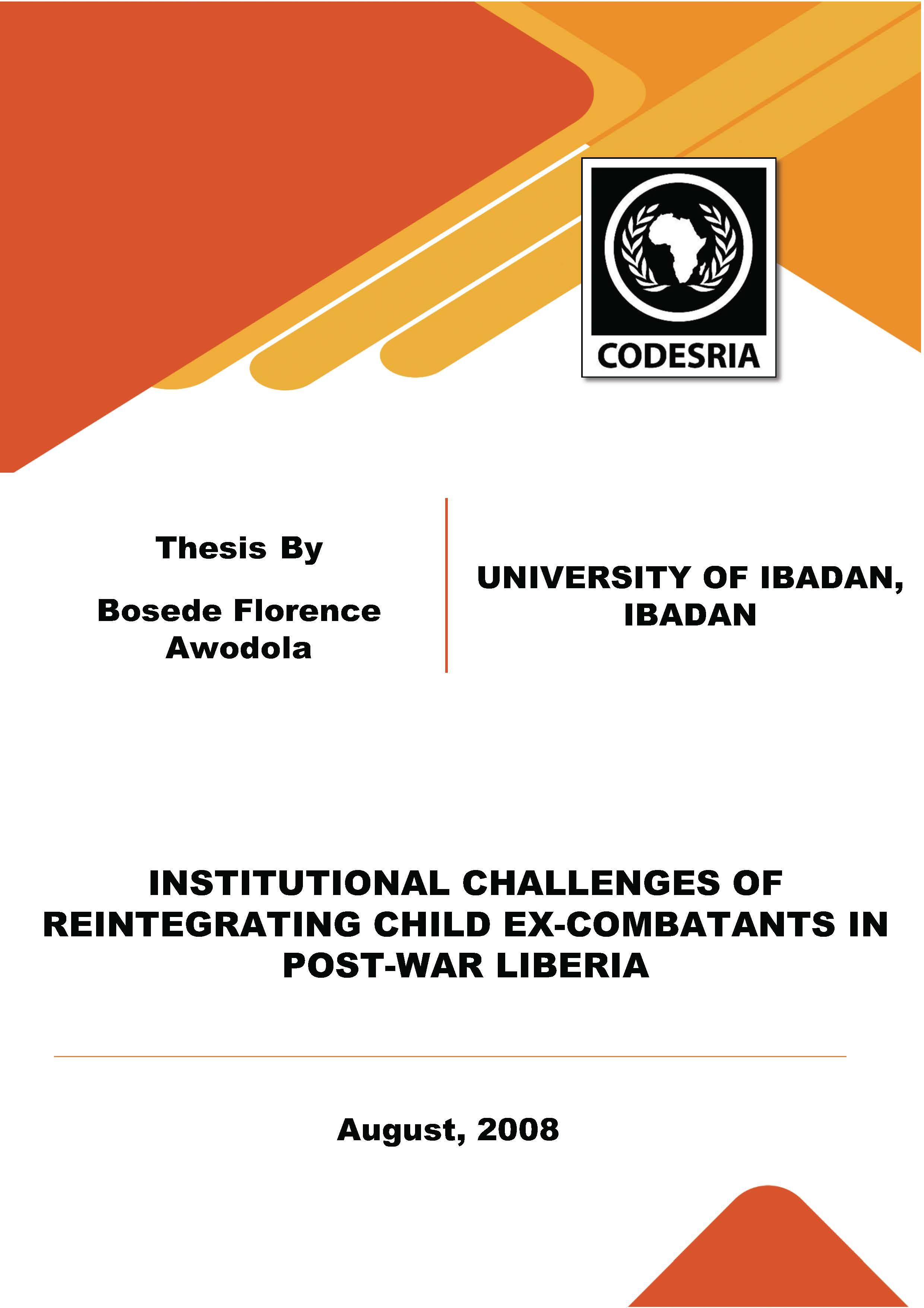Institutional Challenges of Reintegrating Child ex-Combatants in Post-War Liberia
Keywords:
Children, UNICEF, war, civil war, disarmament, international organizations, child soldier, LiberiaSynopsis
Reintegration as a stage in post-war peace process is generally concerned with re-orienting ex-combatants into normal civilian lives. In the case of child combatants, defined as children under the age of 18, whose forced or willing involvement in conflict was a characteristic feature of the Liberian war, the reintegration programme adopted was similar to that applied to adult ex-combatants. The negative consequences of war on the personality of child combatants are largely ignored in most studies. This study examines the appropriateness and level of involvement of child ex-combatants in institutional frameworks of reintegration. The choice of Monrovia as the study site was informed by the large concentration of child ex-combatants – the city being the main scene of the last phase of the civil war in Liberia. Qualitative and quantitative methods were used to obtain data from child ex-combatants and other stakeholders in the reintegration programme. These methods included non-participatory observation, in-depth interviews of 31 key informants, and 13 Focus Group Discussions. Two hundred and fifty copies of survey questionnaire were administered on child ex-combatants who were randomly selected
from the streets, schools, and welfare homes. Descriptive statistics were used for data analysis. Ninety-eight percent of the child ex-combatants had undergone reintegration programme. However, a top-bottom approach in the designing of the programme made it difficult to reflect the social needs of the child ex-combatants. This led to under-achievement of the reintegration variables such as educational support, skill acquisition and family re-unification. Ninety two percent of child ex-combatants lived outside the care of their immediate families; 28% out on the streets. About seven out of ten of the child ex-combatants, whose ages still fell within the child categorisation, frowned at being called child ex-combatants. Fifty-two percent of the child excombatants indicated that the lack of participation from their rank in the design and implementation of reintegration affected their perception of the programme negatively. Their attitude constituted a major challenge in the conceptualisation of the child. The programme equally failed to provide a quasi-family setting to nurture the development of child ex-combatants that could not be reunited with their families. Violent crimes and other deviant acts continued to characterise the behaviour of many of the “reintegrated” children because institutions on which reintegration was rested were not well-equipped to achieve high level of success and sustainability. Inappropriate conceptualisation of reintegration and low level involvement of child ex-combatants in the institutional programme accounted for the low positive impact of the programme. The number of child ex-combatants that still walk the streets of Liberia is an indication that the Liberian reintegration process has achieved minimal success. An approach to reintegration that will treat the child ex-combatants as a socially maladjusted category and, therefore, a target of re-socialisation is recommended. Such an approach would promote prospects for sustainable peace and development.
Downloads
References
Abolade, S. (1990). “Liberia in Turmoil”. The Diplomat, February. 14. Adamu, A. (1999). “Conflict and Conflict Resolution in Industrial Relations”, Course Material for NNPC and CBN Staff. June 1999.
Adedeji, A. (1999). Comprehending and Mastering African Conflicts: The Search for Sustainable Peace and Good Governance. London and New York, Zed Books.
Adekanye, J.B. (2001). “From Violence to Politics: Key Issues Internationally” Paper delivered at the International Ethnic Studies Network (ESN) Conference, University of Ulser, Derry/Londonderry, June 27-30.
Africa Focus Bulletin (2004). “Liberia-Sierra Leone: Consolidated Peace”. In http://www.africafocus.org/docs04/wa0421.php. Accessed: 9th May, 2005.
Africa Policy E-Journal (1996). “Liberia: FOL Report”. In http://www.africaantion.org/docs96/lib9612.1.htm Accessed: 25ᵗʰ June, 2005.
Akers, R. (2000). Criminological Theories: Introduction, Evaluation, and Application. Los Angeles: Roxbury.
Alao, A. and Olonisakin, F. (2000). “Economic Fragility and Political Fluidity: Explaining Natural Resources and Conflict”. In International Peacekeeping, Vol.7, No.4, winter, 29.
Alex P.S. (2000). Thesaurus and Glossary of Early Warning and Conflict Prevention Terms. London: Forum on Early Warning and Response.
Amnesty International (2004). “Al Burundi: Child Soldiers-The Challenge of Demobilization” In http://web.amnesty.org/library/engindex. Accessed: 3rd May, 05.
Amnesty International (2004). “Fulfilling the Promises of Peace for 21,000 child Soldiers”. Al Index: AFR 34/010/2004, News Service No:114.
Anderson, M.B. (1999). Do No Harm: How Aid Can Support Peace or War. Boulder, CO, USA: Lynne Reinner Publishers.






